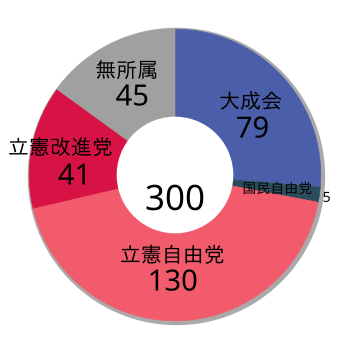Japanese general election, 1890
|
|
|||||||||||||||||||||
|---|---|---|---|---|---|---|---|---|---|---|---|---|---|---|---|---|---|---|---|---|---|
|
|||||||||||||||||||||
|
All 300 seats to the House of Representatives of Japan 151 seats needed for a majority |
|||||||||||||||||||||
|
|||||||||||||||||||||

Results of the Japanese General Elections, 1890
|
|||||||||||||||||||||
|
|||||||||||||||||||||
Japanese general election of 1890 (第1回衆議院議員総選挙? Dai-ikkai Shūgiin Giinsōsenkyō) was the Empire of Japan’s first general election for members of the House of Representatives of the Diet of Japan. It was the first example of a popularly elected national assembly in Asia
Japan’s first general election for the lower house of the national assembly was held on July 1, 1890, in accordance with provisions of the new Meiji Constitution, which had been promulgated in 1889.
The election was based on limited suffrage, with only male citizens 25 years of age and over, who had paid 15 Japanese Yen or more in national taxes, and who had been resident in their prefecture for at least a year, qualified to vote. The number of eligible voters who met this requirement was 450,872 people out of a total Japanese population of 39,933,478 (1.13%). The high tax requirement meant that voter roles were heavily weighed towards rural landlords and urban entrepreneurs. In terms of social class, 91% were commoners, and 9% were ex-samurai. Residents of the prefectures in Honshū, Kyūshū and Shikoku participated; residents Hokkaidō and Okinawa (as “territories”) were excluded from this election. About 95% of those eligible to vote actually cast ballots, although there was no penalty for not doing so.
...
Wikipedia


